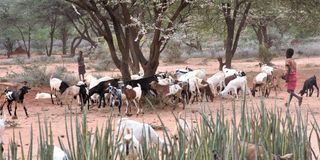Four million Kenyans in need of food aid

A young boy grazes goats at Ngutuk in Samburu East. More than 4 million Kenyans are in dire need of food assistance due to drought, up from 3.5 million in May, 2022.
More than four million Kenyans are in dire need of food due to the biting drought, up from 3.5 million in May, the National Drought Management Authority says.
Lack of rain has made it hard for farmers to plant crops and exposed pastoralists to suffering due to depletion of pastures and water sources.
A majority of those affected are in 19 of 23 arid and semi-arid counties, with Mandera, Isiolo, Marsabit, Laikipia, Wajir and Samburu the most affected and whose drought situation is in the alarm stage.
The other counties are Kitui, Taita Taveta, Tharaka Nithi, West Pokot, Tana River, Turkana, Kajiado, Garissa, Kilifi and Meru North in Meru County.
More than half of Isiolo residents (130,000) face hunger.
During a visit to assess the effects of the drought in Isiolo, NDMA chief executive Col (Rtd) Hared Hassan Adan said the situation in the 23 counties was worsening and that the number of affected people could increase in the next four months.
“The deteriorating situation is due to poor rain performance in March-April-May and the previous season,” Hassan said.
He said more than one million animals had died in the 19 hardest-hit counties, posing a huge threat to pastoralism, the main economic activity in Northern Kenya.
This has forced the affected families to rely on relief food from the government as the few remaining emaciated animals are fetching low prices.
“I appeal to all of you to sensitise the communities on the need to keep manageable herds to cushion themselves against losses when drought strikes,” he said during a meeting of the Isiolo County Steering Group that brought together stakeholders from various government departments and non-state actors.
The drought has also sparked conflicts over resources that have claimed dozens of lives.
Five people were last week gunned down in two separate attacks in Bulle and Kom Durte in Merti sub-county, Isiolo, with the assailants stealing 1,000 cattle.
A majority of water sources have dried up, with residents walking for between five and 16 kilometres in search of the crucial commodity, exposing women to the risk of being attacked by bandits.
Mr Adan asked pastoralist communities to reactivate resource-sharing protocols to ensure peace and avert clashes over pasture and water.
He urged residents to support the government’s efforts to address community conflicts.
The latest NDMA drought assessment report shows that 942,000 children aged below five in the 19 worst-hit counties are acutely malnourished, with 134,000 pregnant and nursing women also acutely malnourished and in need of treatment




